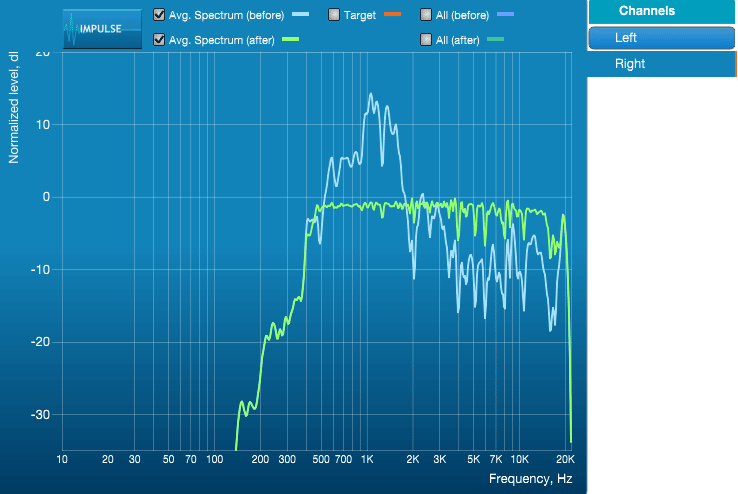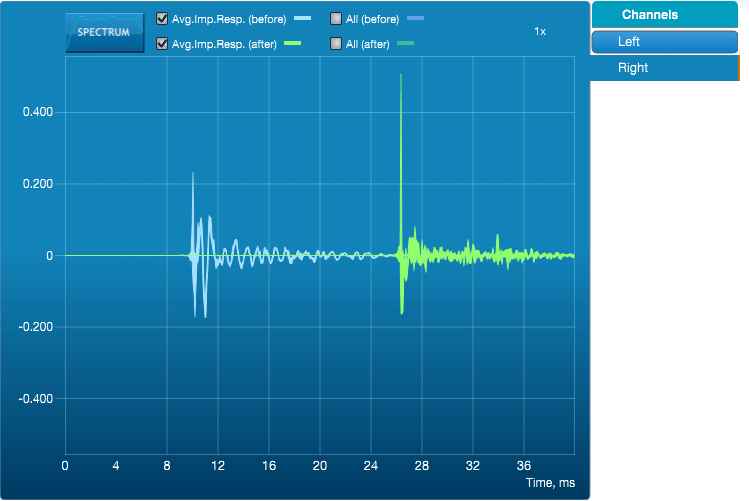I have been using an amp in my own HiFi-system, with built in digital correction of the frequency response, flattening it at hundreds of control points for quite some years now. It really flattens the tone curve and sounds much better, but does little to room reflexions, phase and other faults.
Lately I got my hands on software that installs on a PC and corrects all these aspects, frequency, reflexions and phase faults, on all the material played on the PC, may it be CD´s, files or streaming material, sending it out corrected through any of its ports, like built-in loudspeakers, USB, HDMI or SPDIF-ports.
I set up a “measuring microphone“, which is really just a microphone with calibrated/known frequency response. and made the software play a set of test tone sweeps and bursts through the built-in loudspeakers of my laptop.
The software then calculates the digital filters needed to correct the faults of these cheap laptop speakers. I sit so close to them when working 30-40cm, that the room has very little influence there, mostly direct sound AND the reflections via the laptop sceen, that needs to be taken into account.
The white curve is the measurement before correction, the green after correction with filters.

Not much under 400Hz (the speakers are about 2cm in diameter) or above 15kHz (they don´t point directly towards my ears), so I decided only to apply correction inside this.

Then it also took care of the impulse faults and the ringing (the loudspeaker’s membrane not stopping when the signal feeding it stops). Again the white curve before correction and the green after. See how much more energy where it should be, there is! and the dampening after the spike!
Now to the listening. I used some awesome streamed material of classic guitar. A Swedish guitar virtuoso “Erik Borelius” with his plucks rooted in the “Al de Meola and Paco de Lucia” tradition.
https://www.youtube.com/watch?v=p9MDqgBb89g
Then some CD-material with Andrea Bocelli and Sarah Brightman “Time to say goodbye“, with some of the cleanest voices on earth.
There was a dramatic difference with the filters engaged, the “muffled megaphone coloration” disappeared and the placement of voices and instruments in the stereo-panorama, became much more clear.
After listening for longer periods, it also became clear, that it was much less tiresome to listen with the filters on than off.
I don´t think I will listen to anything on my laptop without DRC again, ever…

Mr Borelius seems to be worth listening more to. I will try to get more of him. His frets on the guitarneck seems interesting, anybody knowing more about this?
You can find more about Erik on http://www.erikborelius.com/welcome-to-erik-borelius/
and the “True Temperament Frets” on https://www.youtube.com/watch?v=YEOY3SqxMc0 and http://www.truetemperament.com/
Fascinating stuff! What equipment do You recommend for DRC at the moment?
With the restart o the blog, I made a listing of three price categories of multichannel amps with Dirac often combined with another DRC like Audyssey XT32 or some proprietary simpler DRC.
Depending on Your demands and wishlist I would recommend one of the amps in the listing at: https://www.drc.one/2024/11/11/the-drc-reciever-benchmark-candidates/
This post was updated 2024-11-19